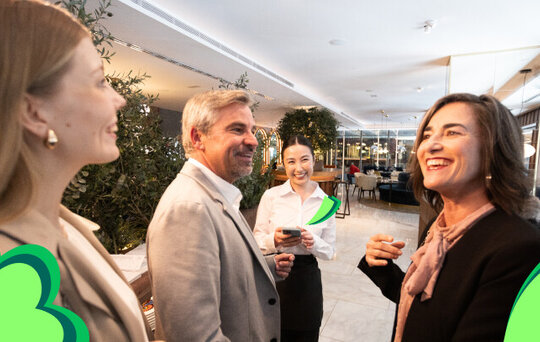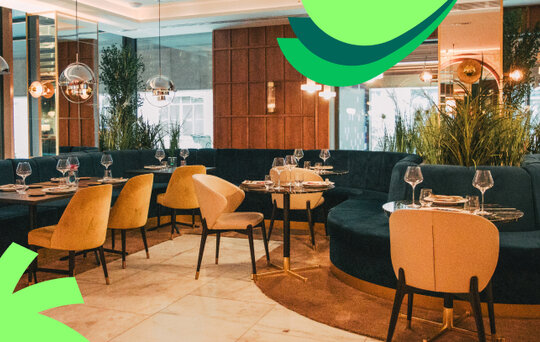How to create a 360 marketing plan for your restaurant

A 360° marketing campaign can be incredibly beneficial for driving the success and growth of restaurants. However, crafting an impactful 60° marketing campaign requires thoughtful planning and strategic design to ensure all elements combine seamlessly and work together to achieve its goals. Don’t worry, we’re here to help you get started.
First things first, what is a 360° marketing campaign? A 360° marketing campaign is a rollout of communication to a range of audiences across multiple channels with a cohesive and consistent brand message. A 360° marketing campaign can be used to support and achieve a range of different goals for your restaurant.
Define your 360° marketing plan goals
Begin your 360° marketing plan by clearly outlining what you want to achieve. Whether your goal is to increase brand awareness, generate more leads or boost sales, having a defined objective will shape your entire strategy and provide a roadmap for success while helping you stay accountable and on track.
Be sure to set specific objectives and identify key performance indicators (KPIs) that will help you measure progress along the way. By outlining these goals and metrics from the start, you'll have a solid foundation for evaluating the effectiveness of your 360° marketing plan efforts and making any necessary adjustments along the way.
Some common needs and goals that motivate restaurants to implement a 360° marketing campaign are:
📋New/Seasonal Menus
📍New Restaurant Opening/Location
🔃 Restaurant Rebranding
📢New Offer/Promotion
Every goal and its corresponding KPIs will require detailed planning and execution when it comes to achieving them. However, no matter whether the goal is part of a paid or organic campaign, there are a few key things to keep in mind when planning creating and launching a successful and impactful 360° marketing campaign.
Know your audience
A key first step when planning your campaign is understanding your audience of diners.
What kind of diners do you want this 360° marketing plan to reach?
When launching a 360°marketing campaign, it’s vital to keep in mind the personas of the customers you want to reach and engage. While many diners may come across your campaign, its true impact and effectiveness hinges on how well you understand the needs and behaviours of those you are trying to reach.
A few examples of campaign audiences are:
- Diners who have never dined with you
- Diners who love a great offer
- Diners who have dined with you
- Diners who love Italian food
- Diners who love high-end restaurants
- Diners between the ages 40-60 or 20-40
Your audience targeting should be specific but not overly narrow, as even those outside your primary target audience may still show interest and help you with building brand awareness. Utilise your restaurant’s database and any previous insights you may have to better identify who your key campaign audience should be.
Try TheFork Manager today
Establish a consistent tone of voice
While your restaurant will maintain its overall tone of voice, a 360° marketing plan should be specific and consistent. The campaign tone of voice may be bolder or more cautious in comparison to your usual restaurant tone of voice depending on the campaign’s goals and target audience.
For example
If your restaurant has a very classic tone of voice and attracts older diners, but the goal of your 360° campaign is to attract younger customers, you will need to adapt your campaign tone of voice to be a little less classic and more modern to grab the attention of your target audience.
Once you have a clear understanding of your audience and have pinned down the tone of voice you wish to achieve you can start thinking about your distribution channels.
Select the right marketing channels for your 360° marketing plan
Once your target audience is identified, deciding on your distribution channels is the next important step.
Each channel attracts a different type of audience and necessitates its unique style of creativity. Identifying and choosing the most relevant channels for your campaign is crucial to ensure that you reach your target audience effectively. For instance, launching a campaign on social media might allow you to better reach a younger, modern audience, whereas doing so through email marketing may be effective for reaching a diverse audience or appealing to your existing customers.
This is a very important first step in how to create a 360° marketing plan as each channel has a different style, viewing functionality and primary audience.
Tailor your creative content for each channel
A 360° marketing plan aims to deliver consistent messaging across a variety of channels including social media, web banners, print or newsletters. To achieve this, it’s important to tailor your creative vision to fit each channel while retaining overall coherence.
Here are some examples of different channels and how content can be tailored to them:
- Instagram Feed Ads can be more visual/photo-driven than text-driven
- Web Ad Banners can be more text-driven with messaging
- YouTube ads will require landscape visuals in video format
- TikTok ads will require portrait visuals in video format
- The newsletter will have space for more detailed campaign messaging
- Instagram Story ads will have limited space for campaign messaging
Sometimes creating the assets for your campaign can be costly or time-consuming, so it's always best to keep in mind which channels will be most impactful and resonate the most with your target audience.
Map out the customer journey
To create a cohesive and effective 360° marketing plan, it’s crucial to outline the various stages of the customer journey, from awareness to post-purchase, to ensure the success of your campaign at different touchpoints.
At the awareness stage, potential customers first encounter your brand. Content here should focus on broad appeal and brand recognition, such as eye-catching ads, engaging social media posts, and informative blog articles that are more likely to pique the interest of potential diners.
Moving into the consideration stage, prospects are looking around and evaluating their options, so providing more valuable content which benefits them can help sway their decision.
During the decision stage, the content of your 360° marketing plan should be persuasive and action-oriented, including special offers, customer testimonials and compelling calls to action.
Finally, in the post-purchase stage, your focus should shift to retention and advocacy. This stage is all about ensuring your customers are happy and more inclined to remain loyal to your restaurant. This includes things like sending email newsletters or participating in loyalty programs to enhance the customer experience and encourage repeat business.
Launching a 360° marketing plan is a great opportunity to reach diners and let them know what your restaurant is all about. Using the information in this article, you can bet on a more impactful launch!
Want to get real-time insights about your restaurant diners to guide your 360° marketing plan? TheFork Manager is a centralised reservation platform designed for restaurants that enables you to gather key information with customisable reports related to reservations, customer feedback and cancellations that can be leveraged to optimise your marketing efforts. Get in touch today to find out more about TheFork Manager and how it can help your business thrive.

















